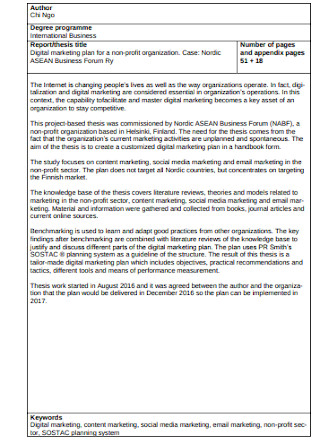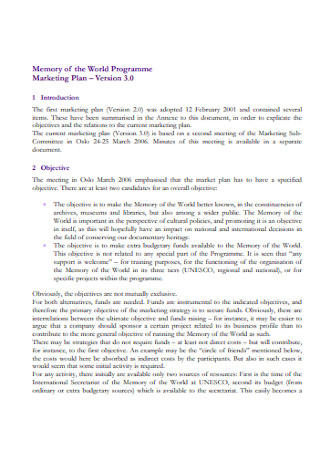Marketing Plan Samples
-

Marketing Plan for Students
download now -

Marketing Plan for Small Business
download now -

Child Care Marketing Plan
download now -

Bakery Marketing Plan
download now -

Digital Marketing Plan Sample
-

digital marketing plan example
-

Non-Profit Organisation Digital Marketing Plan
-

Content Marketing Plan Sample
-

New Product Marketing plan
-

Project Digital Marketing Plan
-

Strategic Digital Marketing Plan Sample
-

Sample Content Marketing Plan
download now -

Content Marketing plan
-

Strategic Marketing Plan
-

Railway Marketing Plan Sample
-

Social marketing plan
-

Basic Massage Marketing Plan Outline
-

Marketing Plan Outline
-

Event Marketing Plan Sample
-

Event Marketing Plan Template
-

Social Media Marketing Plan
-

Sales and Marketing Plan Sample
-

Strategic Marketing Plan Sample
-

Sample Marketing Plan
-

Sample Marketing Plan Outline
-

College Marketing Plan
-

Career Marketing Plan Sample
-

Church Marketing Plan Sample
-

Company Marketing Plan
-

30 Step Marketing Plan
-

Real Estate Marketing Plan Sample
-

30 Day Marketing Plan Sample
-

Basic Property Marketing Plan
-

Sample Property Marketing Plan
-

Real Estate Marketing Plan
-

Fair Housing Marketing Plan Sample
-

Sample Sales and Marketing Plan
-

Marketing Plan Sample
-

Tourism Marketing Plan
-

Basic Marketing Plan Sample
-

Budget Marketing Plan Sample
-

Standard Marketing Plan
-

Marketing Plan Questionnaire
-

Formal Marketing Plan Sample
-

Sample Event Marketing Plan
-

Programme Marketing Plan Sample
-

Basic Strategic Marketing Plan
-

Simple Marketing Plan
-

Sample Marketing Plan Sheet
-

Basic Event Sales and Marketing Plan
download now
FREE Marketing Plan s to Download
Marketing Plan Format
Marketing Plan Samples
Definition of Marketing Plan
Purposes of a Marketing Plan
Types of Marketing Plans
How to Create a Marketing Plan?
FAQS
Who needs a marketing plan?
How often should a marketing plan be updated?
What are the basic components of a marketing plan?
What role does a marketing plan play in competitive analysis?
What is the relationship between a marketing plan and brand identity?

Download Marketing Plan Bundle
Marketing Plan Format
1. Executive Summary
- Provide a brief overview of the marketing plan, including key objectives, target markets, and expected outcomes.
- Summarize the unique value proposition and the overall strategic focus of the plan.
2. Company and Product/Service Overview
- Company Overview: Brief background, mission, and vision statements.
- Product/Service Overview: Details about the product or service being marketed, including features, benefits, and competitive advantages.
3. Market Research
- Industry Analysis: Current state of the industry, trends, and potential growth.
- Target Market: Define your target audience segments, including demographic, psychographic, and behavioral profiles.
- Competitive Analysis: Identify key competitors, their strengths and weaknesses, and your differentiation points.
- SWOT Analysis: Outline strengths, weaknesses, opportunities, and threats.
4. Marketing Objectives
- State the primary goals, such as increasing market share, enhancing brand awareness, generating leads, or launching a new product.
- Set SMART (Specific, Measurable, Achievable, Relevant, Time-bound) objectives.
5. Marketing Strategies
- Positioning Strategy: How you want to be perceived in the market.
- Branding Strategy: Key brand elements and positioning statements.
- Value Proposition: The unique benefit that makes the product or service attractive.
6. Marketing Mix (4Ps or 7Ps)
- Product: Details of the product/service, including variations, features, and lifecycle.
- Price: Pricing strategy, discount structures, and perceived value.
- Place: Distribution channels, locations, and logistical considerations.
- Promotion: Advertising, sales promotions, PR, and digital marketing strategies.
- (Optional for Service Marketing):
- People: Customer service standards, training, and staff involvement.
- Process: The process by which the product/service is delivered.
- Physical Evidence: Tangible aspects that help customers evaluate your offering.
7. Digital Marketing Strategy
- Website Strategy: Outline website goals, UX, content, and SEO.
- Social Media: Platforms, types of content, posting frequency, and engagement metrics.
- Content Marketing: Blog posts, articles, videos, and any educational material.
- Email Marketing: Newsletters, drip campaigns, and list segmentation.
- Pay-Per-Click (PPC): Ad networks, targeting strategies, and budget allocation.
8. Budget and Resources
- Marketing Budget: Breakdown of costs for each area of the marketing plan.
- Resource Allocation: Personnel, technology, and other resources needed.
9. Implementation Timeline
- Milestones: Important dates and timelines for marketing activities.
- Gantt Chart: A visual timeline can be helpful for larger projects.
- Roles and Responsibilities: Who is responsible for each task.
10. Key Performance Indicators (KPIs)
- Define metrics to measure success, like customer acquisition cost (CAC), return on marketing investment (ROMI), conversion rates, and lead generation.
11. Evaluation and Control
- Review Process: Scheduled check-ins to evaluate progress.
- Contingency Plans: Backup plans if certain strategies do not yield the expected results.
Definition of Marketing Plan
A marketing plan is a structured strategy outlining how a business will promote its products or services to reach its target audience effectively. It includes details on target demographics, marketing objectives, budgets, and specific tactics across various channels. You can also see more on Service Marketing Plan.
Purposes of a Marketing Plan

- Define Marketing Goals: Clearly outlines objectives such as increasing brand awareness, lead generation, or market share.
- Target Audience Identification: Helps pinpoint specific demographics to effectively tailor marketing messages and tactics. You can also see more on Sales and Marketing Plan.
- Resource Allocation: Allows for efficient use of resources, ensuring that marketing efforts align with available budget and manpower.
- Competitive Analysis: Provides insight into competitors’ strategies, helping identify unique advantages and opportunities.
- Performance Measurement: Establishes benchmarks to assess the success of marketing campaigns and optimize for future efforts. You can also see more on Marketing Project Plan.
Types of Marketing Plans
- Product-Specific Marketing Plan: Focuses on promoting a particular product or product line within a business.
- Corporate Marketing Plan: Outlines high-level marketing strategies that align with a company’s overall business objectives. You can also see more on Business and Marketing Plans.
- Digital Marketing Plan: Targets digital channels exclusively, focusing on online marketing strategies like SEO, social media, and email campaigns.
- Content Marketing Plan: Emphasizes content creation and distribution to attract, engage, and retain a target audience.
- Brand Marketing Plan: Aims to build brand awareness and loyalty, strengthening the company’s brand in the marketplace. You can also see more on Digital Marketing Plan.
How to Create a Marketing Plan?

Step 1: Conduct a Market Analysis
Begin with a comprehensive market analysis, assessing your industry’s current landscape, trends, and growth potential. Understand your competitors, their strengths and weaknesses, and identify potential opportunities or threats in the market. Gathering this information forms a solid foundation for your marketing plan by offering insights into areas to focus on.
Step 2: Define Your Target Audience
Identifying the right audience is crucial. Outline demographic details, interests, pain points, and preferences. Use market research, surveys, or buyer personas to create detailed customer profiles. Knowing your target audience allows you to create messaging and strategies that resonate with them and lead to higher engagement and conversions. You can also see more on Marketing Execution Plan.
Step 3: Set Clear Goals and Objectives
Establish specific, measurable, attainable, relevant, and time-bound (SMART) marketing objectives. Whether it’s increasing brand awareness, generating leads, or boosting sales, your goals should be clear and aligned with broader business objectives. This clarity helps in evaluating the success of each campaign and the overall plan.
Step 4: Develop Your Marketing Strategies and Tactics
Choose the marketing strategies that align with your goals, such as content marketing, social media, or email campaigns. Outline tactics that will help you implement these strategies effectively. Each tactic should detail the channels, timing, and resources needed to execute the campaigns, ensuring cohesion in your approach across platforms. You can also see more on Annual Marketing Plans.
Step 5: Create a Budget and Performance Metrics
Allocate a budget for each strategy and tactic, factoring in potential costs such as advertising, content creation, and tools. Define key performance indicators (KPIs) to track progress and measure success, like conversion rate, ROI, or engagement rate. A well-defined budget and metrics system helps you monitor performance and adjust strategies as needed.
A marketing plan is a vital component of any successful business strategy, providing direction, focus, and a clear path for growth. By outlining specific goals, target audiences, and tactics, businesses can enhance the impact of their marketing activities and make informed adjustments as needed. A structured marketing plan not only guides a team’s efforts but also enables companies to adapt to market changes, monitor performance, and stay competitive in a dynamic environment. You can also see more on Marketing Communications Plan.
FAQS
Who needs a marketing plan?
Any business or organization aiming to promote its products or services benefits from a marketing plan. It’s essential for businesses of all sizes, from startups to large corporations, to ensure cohesive and effective marketing. You can also see more on New Product Marketing Plan.
How often should a marketing plan be updated?
Typically, marketing plans are reviewed annually. However, adjustments may be needed quarterly or as market conditions change to ensure strategies remain relevant and effective.
What are the basic components of a marketing plan?
Key components include a market analysis, target audience definition, marketing objectives, strategies, tactics, budget, and performance metrics. These elements work together to form a cohesive strategy. You can also see more on Budget Marketing Plan.
What role does a marketing plan play in competitive analysis?
A marketing plan includes a competitor analysis, which identifies competitors’ strengths, weaknesses, and strategies. This analysis helps businesses understand their market position, differentiate their offerings, and capitalize on opportunities that competitors may overlook.
What is the relationship between a marketing plan and brand identity?
A marketing plan aligns marketing efforts with the brand’s identity, ensuring consistent messaging across campaigns. This alignment strengthens brand perception, builds trust with the target audience, and enhances long-term customer loyalty. You can also see more on B2B Marketing Plan.
